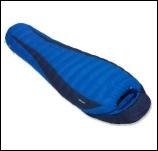|
How Do I Choose A
|
| Bag Type | Comfort Rating (°F) |
| Summer Season | +35° and higher |
| 3-Season Bag | +10° to +35° |
| Cold Weather | -10° to +10° |
| Winter/Extreme | -10° and lower |
Sleeping Bag Fill Options
Next, look at the type of fill you want. The fill is what insulates your bag. The type of fill you have is also a determining factor in weight, compressibility and durability. Backpacking sleeping bags come with either down or synthetic fill. Both have their pros and cons. In order to decide what’s best for you, let’s take a close look at these options.
Down is the soft, fluffy under feathers of birds like geese and ducks. It does a superior job at insulating, while weighing very little. It is able to compact very well and if properly cared for can perform well for years and years.
On the downside, down loses all ability to insulate if it becomes wet and cannot insulate until it dries again, which takes a long time. However, if you are careful and don’t experience frequent extreme weather, your sleeping bag should not be exposed to that much water. Down is also more expensive, but this cost evens out in the long-run due to its lifetime. Also, some people are allergic to down.
Synthetic fill is made of long, thin plastic fibers. A big advantage to synthetic fill is that it is less expensive. It also provides some insulation when wet and dries quickly.
Some of the cons of synthetic is that is it heavier relative to the warmth it provides. Synthetic is also bulkier and does not compact as well as down. The fibers do degrade over time, reducing the effectiveness of your sleeping bag.
How do you choose between the two? Well, for beginner backpackers, people who don’t want to spend lots of money and those who expect to be in the rain a lot, synthetic is probably the best choice. If you’re really needing or wanting the lightest, most compact or warmest backpacking sleeping bag, go with down.
Return from Backpacking Sleeping Bag to Backpacking Equipment
Return to Backpacking Tips Home Page






